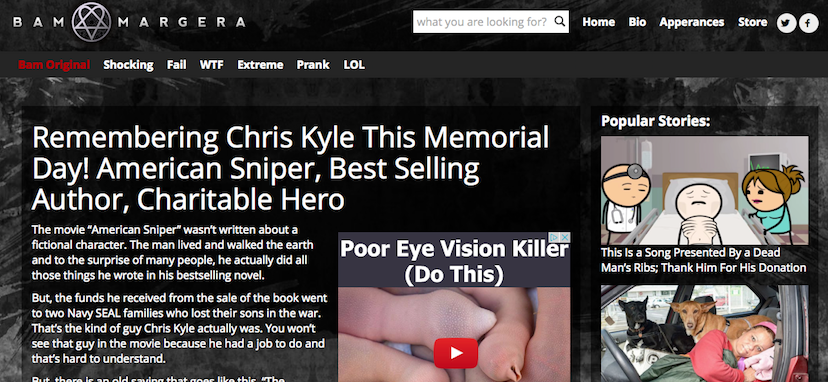Dead Sites Posting

My favorite view of the web is a list of stories that have, according to analytics company Newswhip, achieved “Highest Velocity.” It’s essentially an of-the-moment collection of the most-shared stories on social media platforms (you can see a similar public page here).
The headlines, taken together, tell a familiar story: publications’ sensibilities have conformed to the platforms that send them visitors; their sites have adopted the tone and language of social media; news and entertainment, mixed as ever, now mingle according the demands and preferences of the feeds into which they are deployed. It’s a brutal and honest list: sparse and vital breaking news next to aggregated news so partisan as to transcend the concept of truth; TV casting news next to celebrity social media updates; a first-person video of a man firing two double-barreled pistols next to a story about “The Beautiful Origin Of Memorial Day Conservatives Don’t Want To Talk About”; a story about Real Madrid manager Carlo Ancelotti below a remembrance of American Sniper Chris Kyle; a clip from the reality show “Street Outlaws” followed by flood news from Texas followed by an interview with Matchbox Twenty’s Rob Thomas. “15 things you should do with wine this summer. Number 11 made made me drool!” sits a few stories above “Studies Find Ginger To Be More Effective Than Chemotherapy At Fighting Cancer Cells” just up from “Muslims Say Fallen U.S. Soldiers Should NOT Be Honored on Memorial Day.”
It’s soothing, almost, to see these items together in a list. Yes, they’re formally and ideologically disparate, and, like Most Popular lists in nearly any context, they are not a flattering reflection of their audience. But these stories are not mysterious. They share a teleology: this is a list of things that people consume and engage with most vigorously on social media; this is a list of links that very different people share on platforms to tell other people about themselves.

A Most Popular list created by everyone makes a publication for no one. But it’s easy to see where these stories, even — especially? — the terrible ones, find traction. Some of this garbage is my kind of garbage, the kind of stuff that I might welcome into my feed and even cram into other people’s feeds. The kind of stuff the companies that operate my feeds might deem appealing — or at least engagement-probable! — for me. The rest belongs, just as recognizably, to someone else.
More interesting than the headlines is the list of places that produced them.
Here, in order, are the publications that supplied some of the “Highest Velocity” stories on social media on Tuesday morning of this week, according to Newswhip’s (incomplete) survey: ABC13 (Texas); Comicbook.com; Discovery (as in the channel); Today (as in the show); HLN (channel); the official site of the San Francisco Giants; The Weather Channel; BearingArms.com; the NFL; NASA; National Geographic; CainTV (Herman Cain’s viral site, appears multiple times); TMZ; HollywoodLife; RightWingNews; NBC News; AddictingInfo; the NBA; Qpolitical; Bam Margera’s general interest viral news site; KiroTV (local news in Seattle); ESPN; WorldViralz; HipHopDX; MarcoRubio.com; The Score; Mashable (numerous times*) The Federalist Papers; CBS; SimpleOrganicLife.com.
Starting from a position of total ignorance — imagine some sort of alien inexplicably interested in the content industry — these sources, unlike their stories, are mysterious. What are they? Why are they doing the things they’re doing? They seem to be publishing their stories in hopes of gaining traction among particular factions on services they don’t control. They are providers of content in the most literal sense, supplying liquid volume to fill a set of voids created, or left, in other companies’ systems. Some of them have official partnerships with these systems, indicated either by symbolic blue flair or special content formats and advertising arrangements.
Most do not, which leaves their status somewhat unclear. Are they like… professional users? The unlicensed street vendors of social media? Pushy content club promoters? Feed beggars? They certainly speak and behave in an uncanny way, appropriating the language and poses of human users. Other companies, companies that create things besides content for Facebook — hamburgers, guns, financial instruments, whatever — do this too, achieving similar effects. They tend to be less honest about their subjects but more honest — or at least direct — about their brands.
Now descend one layer to your own Facebook or Twitter feed and try a similar exercise. Who are these people in your feed? What are these things? You will be presented with a more familiar set of non-human entities, partially determined by both intentional and arbitrary filtering. Some of these names will be present because of legacy or prior preference; others you may have discovered more organically and recently. It will all feel a little more intuitive from down here, because it’s customized for you. But it’s still fundamentally strange. Your relationship with these publishers is necessarily mediated by the platform, either through some sort of follow relationship or less directly through a friend relationship.
This has always been the case, here! It just didn’t really matter that much when a site’s traffic came directly, or through many channels as a result of its established existence elsewhere. Now, among sites that get a majority or near-majority of their visits from social referrers, or which hope to publish exclusively on platforms, the issue has gone from curious to existential.
Imagine a reader perspective that totally privileges the feeds — that has known nothing else, and is only interested in what’s happening now and what comes next. The Content Teen of myth. Then reconsider the familiar names in your feeds as mysterious metadata, without assigning to them whatever legacies they might have. And ask again: What are they? Why do they exist? What are they doing, and why are their hosts allowing them to do it?

Every era of media is broken in its own way, so it’s worth thinking about how a platform-centric media might be at least workable. What room is left in the feeds, next to the friends and the brands and the ads? This is a fun thought experiment, depending on where you think you stand. Publications that depend on access will have very little leverage over their subjects; they will soon share not just a platform but a fluid audience with the companies or people they cover. Anything too closely adjacent to brands will get caught in their terrible gravity (which, honestly, is probably for the best). Oppositional journalism seems conceptually safe but also not very shareable (maybe purely performative praise, in a stunning turnaround, begins to seem… pathetic?? Hm). Explainers: the one true social format? Maybe this will be great for breaking news, or, somehow, for local news. Or maybe not at all! Maybe platform ideologies will narrow. Maybe they will work to preserve power or to work to check it. Maybe Apple will make some small change to how its home screens work and undercut every single app-based platform overnight. Maybe the entire internet will just be about how great and merciful the machines are. (Human content creators have a special brand authenticity that machines crave.)
These questions don’t just pertain to newer publications built around social sharing, which, often stunned by sudden investment and growth, default to internally and externally defining themselves in terms of the demographics they can offer advertisers. Older publications, even those with strong institutional identities, are rendered flat in the feed — the most venerable publication is reduced, in a casual reader’s endless cascade, to a slightly more trustworthy username among countless others. Each unit of content is a pitch not just for the story or media it contains, but for whatever brand posted it. (Again: in a world in which institutional identity is more durable, through a subscriber base, a destination site, or demonstrated ownership of a beat — this is obvious but not terribly urgent. On platform internet, it is not.)
In most cases, then, a publisher reliant on platforms — reluctantly or enthusiastically — is required to give up a substantial part of its identity. It borrows its audience. It takes editorial cues from the company from which the audience is borrowed. It rents space not just with promises of unusually high-quality content, but, in some cases, with the splitting of revenue. This is a situation in which success is aligned with sublimation. A truly successful platform publication is not a publication at all. It’s… an agency? (Maybe a truly successful platform publication is just a platform acquisition.)
What’s been easy to miss over the last few years, as traffic to publishers and platforms has exploded in parallel, is how total this loss of identity has been. Sites that want to scale quickly tend to do so through general-interest social arbitrage, resulting in an absurd sameness:
The mix changes; Grantland is some more sports and a little less news and whatever intern is currently writing the “Bill Simmons” column. Slate is a little less sports and a little more politics and Troy Patterson endlessly writing the word “gentleman” into his Mead notebook in cursive while admiring his new glasses in the mirror. New York is a little of everything with some soothing noises to remind New Yorkers that they are very very important. The revamped New York Times Magazine is a lot of the same edited by people who think you can get more sexy Millenials to your website by adjusting the kerning on your font. The Atlantic is a lot of the same plus Ta-Nehisi Coates plus Coates’s creepshow commenters asking him to forgive their sins. Business Insider is a lot of the same only written for the illiterate. The New New Republic is the same stuff written by every non-white male Gabriel Snyder could find to exorcise the vengeful presence of Marty Peretz’s farting ghost, and thank god for that, plus Jeet Heer with an essay made up of 800 numbered tweets. Buzzfeed is a lot of the same only if life was a Law & Order episode about the Internet from 1998. Salon is the same stuff but every single piece is headlined “Ten Things You Won’t Believe Rethuglicans Said on Fox News” regardless of content. Vox is a lot of the same stuff plus a new-fangled invention called the “card stack,” an innovative approach which allows webpages to “link” to other pages. The Awl is a lot of the same stuff brought to you by the emotion sadness. Gawker is a lot of the same stuff, cleverly hidden across 1,200 sub-blogs along with several thousand words of instructions for how to read the site that are somehow still an inadequate guide. Vice is a lot of the same stuff written by that guy you knew in high school who told you he did cocaine but seemed to only ever have that fake marijuana called Wizard Smoke you could buy at a gas station. Five Thirty Eight, I’m told, exists, although whenever I try to open it my browser seems to show me a strange lacuna into which the idea of a website was, once, meant to congeal. But one way or another, you could take 90% of what each of these sites publish and stick it on any other, and nobody would ever know the difference.
That “you could take 90% of what each of these sites publish and stick it on any other, and nobody would ever know the difference” rings true in an additional way: it’s not clear, when it comes to some core types of stories that perform best on social media, that readers care much which publishers stock their feeds.
This would present a problem! If handing over distribution and reader relationships to a platform doesn’t result in consistent distribution or any sort of useful loyalty, then what’s left? Within a site like Facebook, not very much; in the absence of Facebook, god forbid, virtually nothing: a group of employees working under a brand, aimlessly producing content for a container that’s either full or closed. The movement from sites to social platforms threw off so much waste traffic in the beginning, and felt so charitable and affirming, that I’m not sure most participants realize how wide the gap between a coherent, functioning website-centric organization and platform publisher actually is — and how clean the breaks will be.

As the content industry consolidates in weird and unsettling ways over the next few months, understand the stakes: venture-funded publications, aware of how quickly their borrowed social audiences appeared and therefore understanding how quickly they could go somewhere else, will rightly crave security in the form of an exit. The best might go public, and find new ways to justify their independent existence, creating something like full-service content agencies, producing news and entertainment and ads as their ever-shifting context permits. Others will simply attempt to pitch their value to Facebook (or whatever) as something valuable to companies other than Facebook (or whatever). Those purely dependent publications that fail–maybe those middling, boldly cynical latecomer social mills about nothing?? — will take stock of their remaining parts, and realize that they assemble into nothing. They will only be able to lurch forward until the money runs out.
There is something to the idea, casually expressed by some members of the tech industry, that this would represent a cleansing cycle — a period of, sure, creative destruction, leading to a situation in which news and entertainment reach people in ways better suited to they way they live now. This would be a little easier to swallow if it didn’t coincide with a period of dramatic internet centralization. But corporate consolidation, an optimist might say, will create new opportunities for outsiders — it will set the stage for the types of stories the internet produces all the time, of disruption and healthy change and… narrow enrichment? Fresh short monopoly? Interesting Case Studies in Extremely Fast Capitalism?
All of this is to say, for better or for worse, I think the next year is going see a fairly large shaking-out: an elimination of redundancy by platforms that incidentally encouraged it; a choosing of partners and therefore winners and losers; a fundamental change in the terms that publishers thought they had with the platforms they’ve come to depend on, even though the platforms never actually promised anything. Some of the most successful websites may prove to be the most vulnerable. The speed and nimbleness with which they were able to appear, grow and surpass their print-centric predecessors’ publishing businesses on the internet was dazzling; so too will be the speed with which they can disappear.
*NewsWhip displays a sort of sharing trajectory for each link, which usually shows a gradually and accelerating rise. Mashable’s shoot straight up. Their stories, which display similar widgets next to their headlines, seem to be instantly tweeted many, many times upon publication.
Gifs from this video, courtesy of MIT.
